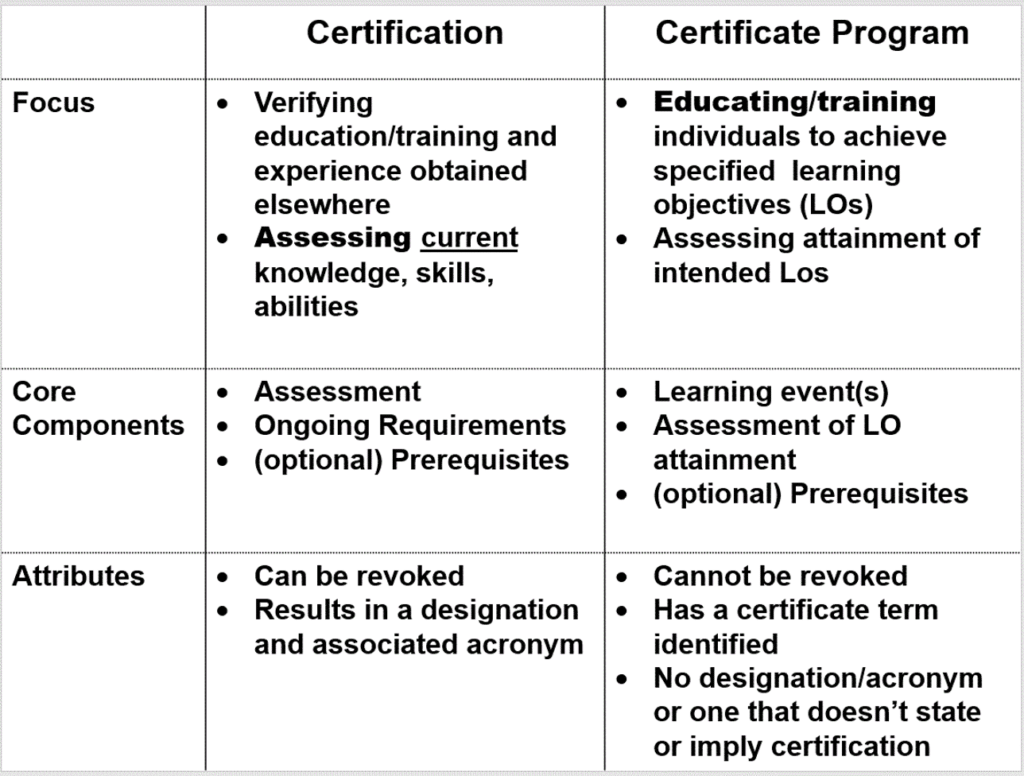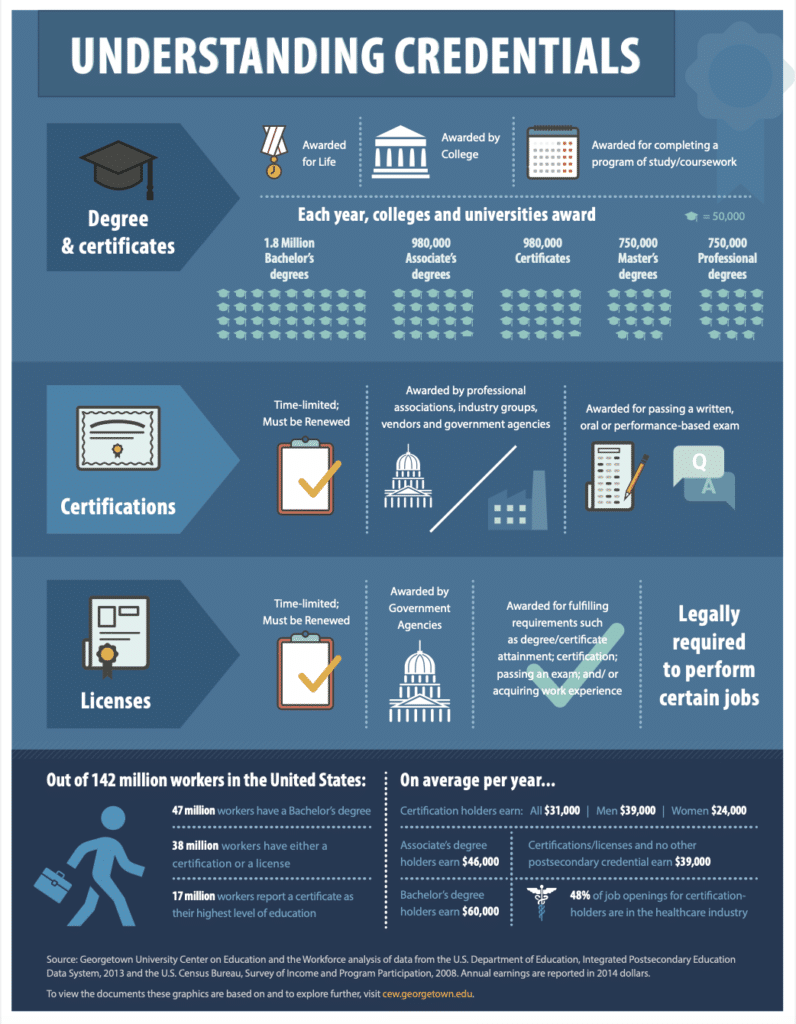Credentials offer more potential than ever to learners and to the organizations offering them. And learning businesses in particular are uniquely positioned to leverage them to address challenges and create opportunities for the people and industries they serve.
In this episode of the Leading Learning Podcast, we share key macrotrends making credentialing even more valuable today and what learning businesses may need to consider when offering credentials. We also break down and compare various types of credentials and their different purposes.
To tune in, listen below. To make sure you catch all future episodes, be sure to subscribe via RSS, Apple Podcasts, Spotify, Stitcher Radio iHeartRadio, PodBean, or any podcatcher service you may use (e.g., Overcast). And, if you like the podcast, be sure to give it a tweet.
Listen to the Show
Access the Transcript
Download a PDF transcript of this episode’s audio.
Read the Show Notes
[00:00] – Intro
The Macrotrends Making Credentialing Even More Valuable Today
[00:35] – Credentials strike us as being of more value than ever in the current moment given four macrotrends:
- Changes in work
People are working longer. Retirement has become less of a standard practice and more of a legend of old. We’re changing jobs and careers more frequently. These changes in work mean more people need more lifelong learning than ever before, and they often need a way to show they have the skills and knowledge employers need—and credentials are a way to do just that. - Growth in access to the Internet and devices like smartphones
The Internet has gotten better. 5G is becoming widely available; even 10G is possible on cable. The combination of portable devices and good Internet makes anytime, anywhere learning more possible than ever. Learning, training, review, and test prep are often needed for an individual to attain or maintain a credential. - A huge surge in content
This has upped the need to help learners find credible, relevant content. Credentials can be a way for learners to demonstrate that they know that credible, relevant content and/or to help them find that content. - COVID
The pandemic changed so much about how we live, work, and learn and accelerated changes that were already happening in the adoption of technology. It’s easy to imagine how the skills or knowledge needed by workers may change—more emphasis on online collaboration skills, effective e-communication skills, or virtual presentation skills, for example. Those are skills that can be credentialed. An example of a credential brought into being because of the pandemic is the COVID-19 Certificate in Prevention & Safety Excellence for Senior Move Managers from National Association of Specialty & Senior Move Managers.
Sponsor: BenchPrep
[05:31] – We’re grateful to BenchPrep for sponsoring the Leading Learning Podcast.
BenchPrep is an award-winning learning platform purpose-built to help learners feel confident and prepared to take difficult entrance, certification, and licensing tests by delivering an intuitive, efficient, and engaging study experience. BenchPrep helps you accelerate test prep revenue growth by offering the tools you need to create market-ready products and data to improve your content and understand learner behavior.
Many of the world’s leading associations, credentialing bodies, test providers, and training companies trust BenchPrep to power their online study programs, including ACT, the Association of American Medical Colleges, CFA Institute, CompTIA, GMAC, McGraw-Hill Education, AccessLex, and more. More than 8 million learners have used BenchPrep to attain academic and professional success. To discover more, visit BenchPrep.
Defining Credentials
[06:33] – To really dig into the potential value of credentials, we need to be clear about what we mean when we say “credential.”
Credential is the umbrella term, and there’s a lot under that umbrella, including non-learning-related credentials. For example, passwords, identification documents, security clearance, and power of attorney are all credentials. We’re not going to focus on non-learning-related credentials, but we want to mention them because they make clear the value of credentials—credentials get you access to something that otherwise would be harder to reach or entirely off-limits.
Academic Degrees, Diplomas, and Licensure
[07:39] – Just as with non-learning-related credentials like passwords, learning-related credentials are primarily about access. One very common example of this is job descriptions that list among the requirements a bachelor’s degree. Academic degrees and diplomas are well-known types of learning-related credentials.
Licensure is the only credential that is required for an individual to practice or operate legally within a jurisdiction, and, in the U.S., that jurisdiction is usually a state. Only governmental agencies confer licensure.
We’re not going to focus on academic degrees or licensure, as those aren’t the domain of learning businesses, but we want to mention them because they are important parts of the credentialing landscape and important terms to understand.
Where we do want to focus is on the kinds of credentials that learning businesses can—and often do—offer.
Certifications and Certificates
[09:25] – We’ll start with certifications and certificates, both because those types of credentials are mainstays in the portfolio of many learning businesses and because certifications and certificates often get confused. They may sound similar, but they are quite distinct and serve different purposes. Before we examine their differences, we need to unpack the term certificate.
One type of certificate is a certificate of attendance or participation or completion. In our opinion, these certificates offer low to no value because someone only has to show up to get one; they don’t have to necessarily learn anything.
Another type of certificate is an assessment-based certificate (ABC). These offer higher value, at least potentially, because they validate learning and focus on two things:
- Providing education or training to teach an individual something specific, as defined by learning objectives or learning outcomes
- Assessing the individual’s attainment of the learning outcomes
See our related episode “The ABCs of Creating an ABC program with Paul Williams of Argentum.”
By contrast, the focus of certification is on assessing an individual’s current knowledge, skills, and/or abilities. Providing education or training is not baked into a certification. A certification focuses on the assessment piece and determining whether an individual currently has the necessary knowledge, skills, or abilities for X or Y.
A certification usually has ongoing requirements , which are often continuing education. Completing the ongoing requirements is important because certifications can be revoked if they aren’t fulfilled. Certificates, on the other, can’t be revoked—they’re issued and done. Another distinction is that certifications can result in a designation for the individual while certificate programs don’t result in a designation.
We want to note that Mickie Rops has been very helpful to us over the years in better understanding credentials. The certification/certificate distinctions we just mentioned are in line with her work and distinctions she makes, based on her deep familiarity with standards like ASTM E2659-18 – Standard Practice for Certificate Programs, ICE 1100: 2019 – Standard for Assessment-Based Certificate Programs, ISO/IEC 17024: 2012 Conformity assessment — General requirements for bodies operating certification of persons, and NCCA Standards for the Accreditation of Certification Programs (the standards developed and adhered to by accrediting organizations, which are relevant if you want your credential to get the outside stamp of approval that accreditation provides).
[13:45] – Certifications and certificates serve different purposes. Certificate programs are appropriate when the target audience has a knowledge gap or skill gap that can be addressed through an outcomes-based training or education program and then be assessed. Certification programs don’t address knowledge or skill gaps; they serve to recognize individuals who demonstrate they already have the knowledge and skills that fall within the scope of certification.
As a learning business, if you’re trying to decide between a certification program or a certificate program, be clear about what the program is intended to accomplish. The goals for the program need to be rooted in an accurate and nuanced understanding of the target audience’s needs and wants. As is so often the case, it all comes back to marketing.
To learn more about credentialing, we recommend these resources from Mickie Rops:
- “Certificate Program vs Certification – What’s the Same? What’s Different?”
- “FAQ: Training for Certification”
- “Certificate Program as Certification Alternate”
- “Credentialing Terminology Is Still Baffling”

Certificate Program vs Certification – What’s the Same? What’s Different?
This infographic from Georgetown University’s Center on Education and the Workforce is another resource to help with understanding credentials.

Understanding Credentials
Microcredentials, Stackable Credentials, and Digital Badges
[14:48] – We’ll touch on three more types of credentials relevant to learning businesses: microcredentials, stackable credentials, and digital badges.
Microcredentials
Defining microcredential is tricky. With a microcredential what’s usually going to be true is the scope of the credential is going to be a little bit less. It will probably focus on one specific competency or a subset of a skill set, much smaller than what a full-blown certification program might aim to assess.
Digital Promise is behind more than 450 competency-based microcredentials for teachers. Teachers don’t necessarily need to go back to school to earn a master’s in education. For some, a microcredential might be a better fit.
Stackable Credentials
[16:58] – Separate credentials can, when accumulated, become more than the sum of their parts. Stacking is a logical application for at least some microcredentials.
Ladderable credentials introduce the possibility that microcredentials or stacked microcredentials can further open up access to other credentials. For example, ladderable microcredentials might lead to undergraduate and graduate programs.
To learn more, check out these articles:
- “Microcredentials: Why Industry Is in the Driver’s Seat”
- “How Stackable Credentials Will Change the Way Bachelor’s Degree Programs Operate”
Digital Badges
[20:15] – A digital badge is not a credential. A digital badge is a representation of a credential. The technology that underlies digital badges, the “digital” part, means there’s data linked to the badge so someone can (ideally) click through to learn more about the badge. There’s a value-add with digital badges when done right versus a paper credential that (a) isn’t easy to share visibly with others and (b) doesn’t have the underlying data associated with it.
We’ll mention Digital Promise again because they use digital badges to represent their microcredentials. Because those are badges that actually follow standards—and this is an area where standards are important, from organizations like Open Badges—you’re able to find out what really lies behind any badge that’s earned through Digital Promise or any other credentialing organization that’s taking badges seriously.
Check out our related episodes “Leading the Open Badging Movement with Wayne Skipper of Badgr” and “The Promise of Digital Badges and Microcredentialing with Jennifer Kabaker.”
Digital badges can look like just a pretty little graphic to put on your LinkedIn profile or Web site. But, when done right, digital badges have valuable role to play in the credentialing landscape.
We’ve just spent time defining terms, but there’s a pretty big problem. Not everyone agrees on these definitions and distinctions or adheres to them. But, where there’s a problem, there’s an opportunity.
If, as a learning business, you’re careful with your words, and you choose your terms carefully, you hold yourself to standards, whether those are external standards from an accrediting body or just your own internal high standards, then your credentials can be viewed by the market as truly valuable. They will stand out from other offerings.
Celisa Steele
The Opportunity for Credentials in the Current Moment
[23:58] – The pandemic and the Great Resignation added fuel to changes already happening in work and life—the macrotrends that we mentioned at the beginning.
This makes the kinds of credentials offered by learning businesses more attractive when compared to full-fledged degrees. They offer a lower cost and less time investment to get a credential. And if the credential is aligned with employer needs and the job market, then it’s even more valuable.
That “if” is so important because the alignment with employer needs and the job market often isn’t done well or is skipped entirely. If a certification or a certificate or any kind of credential is ultimately going to be valuable to a learner, it’s going to be because that learner can do something with it. They’re going to benefit by holding that credential, which usually means that an employer has to value it. A lot of times learning businesses don’t go deep enough in trying to figure out what how to align their offerings with what employers need.
Grow with Google
An initiative to highlight for learning businesses to study is the Grow with Google program, which is a series of certificates created by Google. Class Central publishes an annual list of the most popular new massive open online courses (MOOCs), and, in 2021, 18 out of the top 25 came from Google.
Grow with Google is very attuned to the results that the learners and employers will get out of the program. The coursework is available on Coursera, a platform for MOOCs. MOOCs were all the buzz years ago. Now it’s the certificates associated with MOOCs that are getting the attention. You see that in the business model behind a lot of the MOOC providers. They’ll make the content or course available for free, but you have to pay if you want the certificate.
Once you start connecting them [MOOCs] into credentials, and if you do it well, and if you really align it with the real world and real employers and the real needs of real people, that’s really starting to take off. It’s really changing the landscape out there.
Jeff Cobb
To learn more, check out these articles:
- “Leveraging MOOCs for Professional Development and Continuing Education”
- “Google Enters Higher Ed in a Big Way”
- “How Credentials Can Create Opportunity for More People”
The Value of Credentials
[28:33] – Credentials are a valuable way to address the current upskilling and reskilling needs. Credentials are also helpful for those new to the labor market. In general, credentials are applicable to learners of all ages and career stages.
Years ago we suggested learning businesses could offer a MOOC and a credential to people entering their industry or profession. A MOOC could be a great onboarding option for your average trade or professional association to pursue.
However, as bullish as we are on the potential for credentials, we want to be clear that we don’t believe all learning needs to be credentialed. We’re not advocating a proliferation of credentials.
What we are advocating is looking at this current moment with an eye to what credentials are valuable or might be valuable to your audiences and what you can do to help reduce the barriers they confront when trying to get those credentials.
Think through what the barriers are (time, money, etc.). With the different approaches to credentials, there are different options that can potentially help you address the barriers your audience might be confronting.
When and if you do offer a credential, follow high standards, and focus on providing a valuable, meaningful credential that the market needs.
[31:11] – Wrap-up
Reflection Questions
As we wrap up this look at credentials, we encourage you to take time for an informal audit.
- If you offer credentials, do they fit the current moment? Take a look at what requirements you have in place for existing credentials. If you have certifications, are the prerequisites that you have in place truly needed? Think about what the barriers are for your audience.
- If you don’t currently offer credentials, is there an opportunity for you to pursue offering one?
If yes, you might develop it on your own or look for a partner.
To make sure you don’t miss new episodes, we encourage you to subscribe via RSS, Apple Podcasts, Spotify, Stitcher Radio, iHeartRadio, PodBean, or any podcatcher service you may use (e.g., Overcast). SSubscription numbers give us some visibility into the impact of the podcast.
We’d also be grateful if you would take a minute to rate us on Apple Podcasts at https://www.leadinglearning.com/apple. We personally appreciate knowing there are others on this learning and leading journey, and reviews and ratings help us show up when people search for content on leading a learning business.
Finally, consider following us and sharing the good word about Leading Learning. You can find us on Twitter, Facebook, and LinkedIn.
Episodes on Related Topics:
- Credentialing and Certification with Mickie Rops
- The Limitless Power of Credentials with Adrienne and Keith Segundo of Limitless ASR
- The ABCs of Creating an ABC program with Paul Williams of Argentum
- Leading the Open Badging Movement with Wayne Skipper of Badgr
- The Promise of Digital Badges and Microcredentialing with Jennifer Kabaker




 Elevating the Learntech Discussion with Tamer Ali
Elevating the Learntech Discussion with Tamer Ali
Leave a Reply